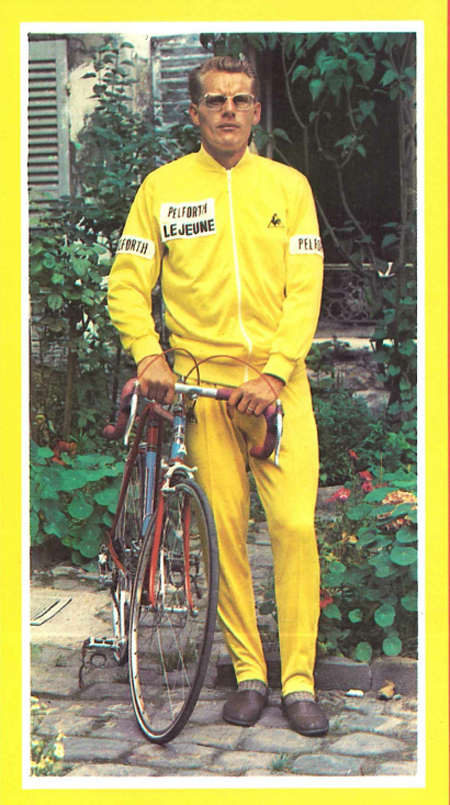As the Le Coq Sportif tracksuit celebrates its fifth decade, David Hellqvist looks closer at how it has changed over the years and what defines the tracksuit’s allure


Answer me this, what is sportswear? Over the last few decades, and especially in recent years with the fashion industry taking a bite out of the term and claiming it as its own, the meaning of ‘sportswear’ has changed. These days it’s not so much actual sportswear, the kind of garments athletes wear when training or competing, but a loose term for casual and contemporary leisurewear. These clothes aren’t designed to be exercised in but to be worn when relaxing in your spare time or, for that matter, going to work. As fashion became less formal in the 1960s, it looked towards the world of sport for inspiration; the idea of movement, facilitated in a comfortable way, became the lead word for how a whole new generation dressed. There are a handful of garments, such as t-shirts, sweatshirts and tracksuits, that have come to define this grey area, the twilight zone between sportswear and leisurewear, as pieces of clothing that sit comfortably in both areas.
But the tracksuit, more so than the other mentioned garments, has struggled to completely integrate itself into sartorial society. Unlike the t-shirt and sweatshirt, it’s not so commonly worn, even broken up and styled separately. “I suppose the tracksuit has connotations, some of them founded but many of them unfounded. They don’t necessarily reek of an effort being made — maybe they’re the wrong kind of effortless to some people,” suggests Gary Warnett, a writer, footwear expert and tracksuit aficionado. Warnett also has another theory for the tracksuit’s uphill battle: “I blame Jerry Seinfeld after he lambasted George Costanza for wearing sweatpants!” Neil Bedford, a photographer working with Wonderland, Kinfolk, Green Soccer Journal and Highsnobiety, to mention but a few, acknowledges the sportswear connection: “My take would be because it’s something heavily associated with sport and not fashion. It might be that it’s too casual for some people to accept as appropriate daily wear – but I’m not sure as I have no negative views of a tracksuit.”
“I feel a bit sorry for people that see themselves above an item of clothing”
Bedford argues too much is made of the tracksuit’s alleged problem, though. “It’s easy to over think everything, but there’s enough going on in the world to not look down on an specific clothes, I feel a bit sorry for people that see themselves above an item of clothing.”
Le Coq Sportif, the French sports apparel and footwear brand, is not above any item of clothing – and especially not the tracksuit. In the mid-60s, the brand developed a tracksuit suitable for the leisurable seventh day off, having worked hard for six days. “I think it’s fair to say the tracksuit, and our development of it, can be seen as a defining moment in the brand’s history,” says Le Coq Sportif’s Ben Ari Grant, “as it enabled us to take the core ideals of production quality and well-considered design that we had been applying to professional sportswear for years, and replicate that on a commercial scale.” Le Coq Sportif is a brand born out of innovative knitting techniques at the turn of the 20th century. At a time when athletic clothing was made using fabrics that were normally the preserve of workwear garments, and therefore counter-intuitive to the needs of a sportsman, Emile Camuset, the brand’s founder, began developing cotton ribs, brushed fleece and jerseys that allowed for increased comfort and breathability. This was a time when, as the idea of casual sportswear was developed and the concept of a suit, tie and hat as an everyday uniform, especially during weekends, was decommissioned. As a direct result, men and women needed new wardrobe stapes. “Yes, as the traditional six-day working week spent in heavy workwear or a stiflingly smart suit gave way to increased weekend time, often spent in the countryside or at home with the family, Le Coq Sportif was able to provide a comfortable yet stylish alternative, which preserved a distinct sense of masculinity and elegance,” Ari Grant says.
“There’s also that hidden athlete in me that still gets excited about wearing a full tracksuit, the power that it brings with being an athlete can be brought into the normal world”
But for many staunch supporters, there very simple reasons why the tracksuit works: “Ultimately it’s about comfort and you being comfortable with what you wear and a tracksuit does that for me, whether it’s a luxury one or something from a sports brand,” says Bedford. “For me, it’s simple – it’s clean and easy to be worn straight out of the shower. It takes very little effort to put one on and allows you the freedom of movement all day that you don’t get from, for example, denim.” Gary Warnett takes a similar point of view: “I feel free in it… It’s a grown up romper suit in many ways – forget all this stupid onesie talk. There are options too – it’s modular. A lot of the slimmer, tailored versions seem a bit try hard, which a tracksuit should never be.”
Bedford also acknowledges the humble beginnings of the garment. “There’s also that hidden athlete in me that still gets excited about wearing a full tracksuit, the power that it brings with being an athlete can be brought into the normal world. If I had the opportunity to have been involved in sport, I don’t think I’d have worn anything but sportswear and tracksuits!” And this is where Le Coq Sportif steps up. “Our products are designed to deal with the rigours of sport, so despite being premised on the idea of the ‘7th Day’, the tracksuit is of course well suited to being worn all week in a more leisurely capacity,” Ari Grant explains.
In 1964, Le Coq Sportif launched what would become its archetypal leisurewear tracksuit: the ‘7th Day Suit’. Since then the garment has been developed and improved, altered to answer new demands and fit with the aesthetic quirks of each decade, as these images show. But, according to Ari Grant, the garment is essentially the same now compared with 50 years ago: “The spirit of the tracksuit is the same, and I think that’s apparent in our desire to respect the elegance of the original 1964 design in our 50th anniversary version,” he says. “There are of course some differences which consumers would expect to find; we haven’t ignored the evolution in our own manufacturing techniques, so the quality, fit and feel is modernised, while we have changed the shape and detailing of the collar for example.” A lot has changed over the last five decades. The way we dressed in the 60s compared to the 80s and the 00s differ, as part of a natural style progression. The same goes for the Le Coq Sportif tracksuit.
“The 1980s were without a doubt the most ‘different’ of the past five decades,” Ari Grant summaries. “I suppose, in many people’s minds, it was an era dominated by the tracksuit, with the introduction of the polyester-based shell suits providing the basis for brighter colours and geometric patterns, which in turn contributed to its adoption into the style language of various sub-cultures that were growing in popularity at the time.” Today, the brand thrives on those connotations: “We’re very proud to be equally associated with quality and comfort by East Coast hip-hop fans as we are with those who remember Diego Maradona famously lifting the World Cup in 1986.”
Whatever day of the week it is, whether you’re into music or sport, the tracksuit is as relevant today as in 1964.
Archive images courtesy of
Le Coq Sportif


Above: 2014




